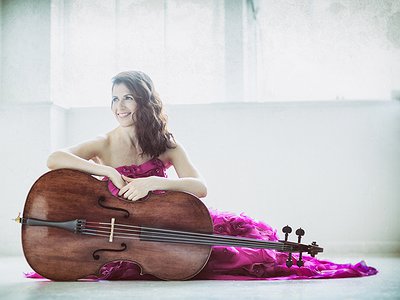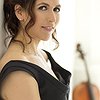Name: Inbal Segev
Nationality: American-Israeli
Occupation: Cellist
Current Release: Chopin, Schumann, Grieg with Juho Pohjonen on AVIE
Recommendations: The Panoramic View of the Palace and Gardens of Versailles at the Metropolitan Museum of Art in New York City is a strange, yet striking painting that inspired composer Timo Andres to write a new cello concerto for me. I premiered it this April at the museum and hope to come to Germany to play it for you sometime soon.
Website / Contact: If you enjoyed this interview with Inbal Segev, visit her website for current updates and music.
When did you start playing your instrument, and what or who were your early passions and influences? What is it about music and/or sound that drew you to it?
I was five when I started playing the cello. I used to dance on the shaggy carpet in our living room in Jerusalem to cellist Paul Tortelier’s Bach suites recording (on vinyl record) and it had the most captivating warm tone. I tried to decide which suite was my favourite but could never make up my mind.
For most artists, originality is first preceded by a phase of learning and, often, emulating others. What was this like for you? How would you describe your own development as an artist and the transition towards your own voice? What is the relationship between copying, learning and your own creativity?
Great question. I was a pretty arrogant teenager (aren’t they all?) and didn’t listen much to anyone apart from Du Pre and Rostropovich on occasion. When I was in my twenties I met my teacher Bernard Greenhouse and for the next few years I basically copied him. I was in awe of his gorgeous sound and ways of making music. Since then I still listen to him play and to many other great artists, violinists and pianists included. One can learn a lot from copying but of course, little by little I found my own way and realised that I did not agree with everything Greenhouse taught me, or anyone for that matter. It took time and courage to find my own voice. This process accelerated as I prepared to record the Bach cello suites. I read about Bach’s life, Baroque practice and composition, Anna Magdalena’s manuscript literally under a magnifying glass and attended historically informed performances. This has now become part of my routine.
What were some of your main artistic challenges when starting out as an artist and in which way have they changed over the years?
When starting out, I, like everyone else, was preoccupied with the craft and with aspects of interpreting the great works of the past, keeping in mind the relation to the recordings and great performances that came before me and of my contemporaries.
I am still working to improve but I am now more interested in looking forward than looking back. Also, the comparisons are more in relation to my own playing and less to others. My new recording is of old repertoire, which I grew up playing, but commissioning new works and working with living composers - as well as teaching - is increasingly more important. As an artist I want to contribute something unique to the world while passing along to my students the information that was given to me by my own teachers.
Tell us about your studio/work space, please. What were criteria when setting it up and how does this environment influence the creative process? How important, relatively speaking, are factors like mood, ergonomics, haptics and technology for you?
For the past eight years or so I have had a studio, which is a wonderful space.
After years of practicing in bedrooms (as you know, space is very expensive in New York) it is “a room of one’s own” in the best sense. The studio has a lot of light but also shades to block direct sunlight which is not good for my 1673 Rugieri cello. It is free of clutter and I furnished it with soothing, light colours. Mood and efficiency are of course extremely important - admittedly I like to waste time, it is a pleasure. But I can also be very efficient when I need to be.
I recently learned a new and difficult concerto in a month, but ideally I like to have more time with new work before performing it. I have bouts of high energy and stress followed by rest. I love alternating being on the road and being at home with my husband and three kids.
Technology is a great tool that we have now. I post a masterclass every week on YouTube and reach thousands of students from all over the world, Germany included, but also countries in South America, the Far East, and Australia. I am particularly proud to teach underprivileged communities and the letters of gratitude that I receive from my students are priceless.
Tell me about your instrument, please. What was your first instrument like and how did you progress to your current one? How would you describe the relationship with it? What are its most important qualities and how do they influence the musical results, including your own performance?
My first instrument was a very shiny 1/8 size little cello that I received when I was five years old. I have played on many different cellos over the years. Beginning with cheaper, modern cellos, little by little I was able to borrow better instruments.
When I played for Zubin Mehta for the first time I was 16 and he immediately arranged for me to have a very nice Vuillaume to play on. I later played on a beautiful Nicolo Amati that was loaned to me while I was a student at The Juilliard School. I now own my Rugieri cello which has just the right combination of richness of sound – almost mellowness – and power. It is a wonderful instrument and it inspires me to play better. I always prefer dark-sounding instruments although I play a lot of solo engagements.
For me a real cello sound is always dark. That said, I recently bought a Carl Becker cello which is very powerful, and it will be interesting for me to find my voice with this newer cello. I like the idea of collecting instruments; the different characters can teach us a lot about the possibilities of colours - we are like singers that can alternate between being a baritone and a tenor.
Could you take us through a day in your life, from a possible morning routine through to your work? Do you have a fixed schedule? How do music and other aspects of your life feed back into each other - do you separate them or instead try to or instead try to make them blend seamlessly?
Music is definitely an integral part of my life and in turn, my husband and kids’ lives. I plan my day around my practice and concert schedule and recently, also around writing and filming my vlog masterclasses “Musings with Inbal Segev.” The only time the cello is not around is when we are on vacation a couple of times a year but even then, we talk and read about music and of course, go to concerts. This summer our vacation is centred around J.S. Bach. We start at Eisenach, continue to Weimar and Leipzig, and end in Berlin. My children could possibly write a PhD dissertation about life in music at this point.
It is a hobby as well as a profession. And managing my career has been a hobby for my husband for the past 10 years. We frequently travel together when I play and he is the most wonderful and supportive partner I have ever imagined I could have. A typical day at home starts with breakfast (coffee!!) and an hour at the gym. Then e-mails. Practice is usually around 11 or 12 for a couple of hours. I also write notes for my YouTube masterclass vlogs, sometimes ideas come to me while I practice and so I have my iPad handy to write notes.
The kids come home from school at around 3:30pm and I spend time with them. I practice more in the afternoon if I have a concert coming up.
I also read more now that the children are older and need me less. I actually just finished a book about Beethoven’s life.



